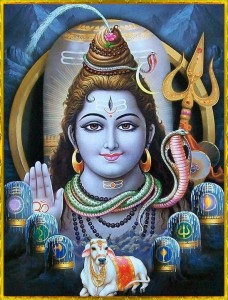
One night of each year in the Vedic or Indian calendar is dedicated to worship of Lord Shiva. This sacred holiday is known as Maha Shivaratri – the great night of Shiva. According to mypanchang.com, Maha Shivaratri 2015 falls on Tuesday, February 17 in India, Europe, Africa, Australia and those in the Central and Eastern time zones in North America. For residents of Hawaii and those residing in the Pacific and Mountain time zones in North America, Maha Shivaratri falls on the night of February 16. The difference is due to the fact that the holiday is celebrated according to the lunar calendar and phases of the Moon will vary.
In the Vedic tradition, there is a trinity of the major GODs: Brahma (the Governor), Vishnu (the Operator), and Shiva (the Destroyer). Shiva translates as “the auspicious one”. Shiva’s worshipers know him to be compassionate and merciful. He protects his disciples from vices and bestows them with his grace. Shiva removes that which has outlived its usefulness and then allows us to start anew. He can remove our limitations, negativities and false beliefs. He brings about radical transformation.
He has a crescent Moon on his head. It represents the cycles of time and that Shiva himself is the master of time. Shiva has a snake around his neck. The snake is a symbol of the kundalini shakti, or spiritual power inside all of us. Shiva’s trident represents the three spheres or wisdom, desire, and implementation.
Shiva has many names. Each name is meant to describe various attributes of him. Some names are: Nataraj, Mahadeva, Mahesh, Rudra, Ugra, Ardra, Maheshwara, Shambho, Shankara, and the list goes on. Each name describes a specific quality of the lord’s multi-faceted being. Shiva is “Mahadeva” – the great lord. Shiva also means “that which underlies.”
On this auspicious and sacred night, it is said that one repetition of the mantra “Om Namah Shivaya” is magnified 1,000 times. Due to the great merit of this mantra repetition (or japa), it is customary people to gather and stay up all night chanting the sacred mantra. People typically fast on this day or refrain from eating grains. Steamed milk with aromatic spices if prepared and served or left outside in the moonlight. White clothing is traditionally worn on Shivaratri.
On Maha Shivaratri 2015, the Moon in Vedic astrology falls in the nakshatra or constellation of Uttara Ashadha. Uttara Ashadha is associated with Lord Ganesha, who is the son of Shiva and Parvati. There is the theme of ongoing refinement with this constellation.

The rudraksha mala is traditionally associated with Lord Shiva. It is said that Shiva cried tears when he saw the suffering of humanity and these tears fell to the ground and formed seeds which grew into the rudraksha tree. Thus, the mala is a symbol of purity. Rudra is another name for the fierce form of Shiva. Aksha translates as “eyes”. When doing mantra japa to Shiva, it is beneficial to use a rudraksha mala if possible.
While chanting is common in groups and at ashrams, spiritual retreat sites, etc., the focus in entirely inward. As we chant “Om Namah Shivaya” (I honor Shiva – the supreme being who resides in each of us), we can connect once again to our own innate divinity and acknowledge that there are multiple facets to our own great being. We can also recognize the divinity that exists in each of us and honor that time and again.
An abhishek or a ritual bath to a Shiva lingam is traditionally performed on Shivaratri. The lingam is bathed with a mixture of milk, ghee, honey, yogurt, and sugar.
If you would like to participate in a Shivaratri puja on Maha Shivaratri 2015, you may do so via Shri Krishna Yajurveda Pathashala in Satara, India. They will perform an abhishek to a Shiva lingam and chant the mantra “Om Namah Shivaya” 2,100 times. Each participant will receive the blessings that this sacred ceremony bestows. For information on how you can personally participate, please send an email to Vvishwajit@gmail.com.
Recent Comments
http://Oswal%20Dilip
February 2, 2015 at 10:21 pmInformation given regarding Maha Shivratri is very very nice I liked your article on Mahashivratri
Comments are closed.